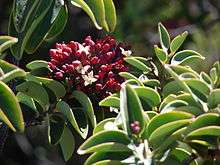Santalum haleakalae
| Santalum haleakalae | |
|---|---|
 | |
| Scientific classification | |
| Kingdom: | Plantae |
| (unranked): | Angiosperms |
| (unranked): | Eudicots |
| (unranked): | Core eudicots |
| Order: | Santalales |
| Family: | Santalaceae |
| Genus: | Santalum |
| Species: | S. haleakalae |
| Binomial name | |
| Santalum haleakalae Hillebr.[2] | |
Santalum haleakalae, known as Haleakala sandalwood[3] or ʻIliahi in Hawaiian, is a species of flowering tree in the European mistletoe family, Santalaceae, that is endemic to the island of Maui in the Hawaiian Islands, part of the United States. It grows in subalpine shrublands at elevations of 1,900 to 2,700 m (6,200 to 8,900 ft), especially on the slopes of Haleakalā.[4]
References
- ↑ World Conservation Monitoring Centre 1998. Santalum haleakalae. 2006 IUCN Red List of Threatened Species. Downloaded on 23 August 2007.
- ↑ "Taxon: Santalum haleakalae Hillebr.". Germplasm Resources Information Network. United States Department of Agriculture. 2006-05-12. Retrieved 2011-03-08.
- ↑ "Santalum haleakalae". Natural Resources Conservation Service PLANTS Database. USDA. Retrieved 5 November 2015.
- ↑ Merlin, Mark D; Lex A.J. Thomson; Craig R. Elevitch (April 2006). "Santalum ellipticum, S. freycinetianum, S. haleakalae, and S. paniculatum (Hawaiian sandalwood)" (PDF). Species Profiles for Pacific Island Agroforestry. Agroforestry Net, Inc. Retrieved 2009-01-30.
External links
 Media related to Santalum haleakalae at Wikimedia Commons
Media related to Santalum haleakalae at Wikimedia Commons Data related to Santalum haleakalae at Wikispecies
Data related to Santalum haleakalae at Wikispecies- "Sandalwood trade". Hawaiʻi History Library. HawaiiHistory.org.
- "iliahi". Hawaiian Ethnobotany Online Database. Bernice P. Bishop Museum.
This article is issued from Wikipedia - version of the 10/31/2016. The text is available under the Creative Commons Attribution/Share Alike but additional terms may apply for the media files.
